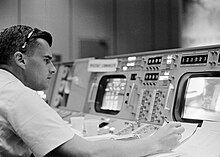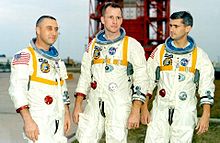Roger B Chaffee
| Roger B Chaffee | |
|---|---|

|
|
| Country: | USA |
| Organization: | NASA |
| selected on | 17 October 1963 ( 3rd NASA Group ) |
| retired on | January 27, 1967 Death on Apollo 1 |
Roger Bruce Chaffee ( February 15, 1935 in Grand Rapids , Michigan – January 27, 1967 in Cape Canaveral , Florida ) was an American astronaut . He died in the Apollo 1 disaster .
biography
For the first seven years of his life, Roger Chaffee grew up in Greenville , Michigan , with his parents, Don and Blanche Chaffee. Don Chaffee was a biplane pilot who earned his money with passenger and parachute flights and from 1942 as a employed pilot of the US artillery . When he took his son on a flight across Lake Michigan at the age of seven, he immediately knew that he wanted to be a pilot.
Roger Chaffee's interests at a young age were model aircraft and music , which he was interested in from his school days. He learned wind instruments and formed a dance combo with others in high school .
At thirteen, Chaffee joined the local Boy Scouts , where he quickly earned his first achievement badges. At school, his interests lay in the scientific subjects such as mathematics and chemistry . Electronics aroused his special interest .
From high school to naval pilot
After graduating from school in 1953, Roger Chaffee applied to several universities and finally began his studies at the Illinois Institute of Technology in Chicago in the fall semester , for which he received a US Navy scholarship through the Naval Reserve Officer Training Corps (NROTC) program. In 1954 he decided to combine his passion for flying and technology in his studies and to become an aeronautical engineer. This was best accomplished at Purdue University in Lafayette , Indiana .
In September 1955 he met his wife from Oklahoma City and they married in August 1957.
On June 2, 1957, Roger Chaffee received his bachelor's degree from the university , where he had just passed his pilot 's license exam . His military flight training continued in Pensacola , Florida , where he flew the Beechcraft T-34 Mentor and the North American T-28 Trojan. He later trained in Kingsville , Texas on the Grumman F9F Cougar Jet.
In 1958 he had a daughter and in 1961 a son.
After completing his flight training, he went through various Navy aviation jobs until becoming a quality officer with Heavy Photographic Squadron 62 , based in Jacksonville , Florida . One of the assignments was to photograph the newly built Cape Canaveral .
From the Navy to NASA
After the first Mercury astronauts were named, Roger Chaffee's interest turned in that direction. He focused his further education and training on the goal of being selected as an astronaut.
In 1963 the third group of astronauts was recruited by NASA ; Chaffee was among a group of 1,800 applicants.
In 1962, Chaffee was offered a postgraduate master's degree in industrial engineering in Dayton , Ohio . He moved with his family, but without neglecting the astronaut selection tests. NASA informed his family of his selection while he was on a hunting trip. On October 18, 1963, Chaffee flew to Houston and was officially inducted into the astronaut corps.
In 1964, after the family moved to Houston, Roger Chaffee began astronaut training. This included not only further flight training, but also survival training for failed land or water landings, as well as studying the lunar surface , as the third group of astronauts had to prepare for the moon landing . The training sessions also included EVA (space exit) training in a large pool of water.
When astronaut Theodore Freeman died during a training flight on October 31, 1964, Roger Chaffee had the honor of carrying the coffin with other colleagues at the funeral . This was repeated with astronaut Elliot See , who crashed with fellow pilot Charles Bassett two years later.
One of Chaffee's first major assignments was to act as communications assistant on the Gemini 4 mission in June 1965. He also flew a mission with Gus Grissom as an escort on an unmanned Saturn 1B mission to photograph its launch.
AS-204 ( Apollo 1 )
Shortly after the flight of Gemini 8 with Neil Armstrong and David Scott in March 1966, NASA announced the crew members for the first manned Apollo mission. Gus Grissom was named as commander , along with Ed White as chief pilot and Roger Chaffee as pilot. The mission was scheduled to launch in early 1967.
Over the next few months in Downey , California , the crew got to know their CSM-012 Apollo spacecraft inside and out, which was being assembled at the facility there.
Since the Apollo spacecraft had not yet reached the mature status of the previous Gemini models, the launch was postponed and further tests were scheduled.
A crucial test took place on January 27, 1967 at the launch pad in Cape Canaveral . The entire crew, namely Grissom, White and Chaffee, took their places in the command module to carry out a plugs-out test . However, during testing (probably from a short circuit or arcing ) the interior of the capsule caught fire. All three astronauts were killed.
Chaffee was buried in Section 3 next to Gus Grissom at Arlington National Cemetery near Washington with a state funeral.
particularities
- Chaffee was first fatality in a spacecraft ( Apollo 1 ) , along with Virgil Grissom and Edward White .
- Chaffee's name is listed on the metal plate of the Fallen Astronaut , the only piece of art on the moon.
- The lunar crater Chaffee on the far side of the moon is named after him.
See also
web links
- Short biography of Roger B. Chaffee at spacefacts.de
- NASA Biography by Roger B. Chaffee (PDF)
- Biography of Roger B. Chaffee in Encyclopedia Astronautica
- Roger Bruce Chaffee at arlingtoncemetery.net
itemizations
| personal data | |
|---|---|
| SURNAME | Chaffee, Roger B. |
| ALTERNATIVE NAMES | Chaffee, Roger Bruce |
| BRIEF DESCRIPTION | American astronaut |
| BIRTH DATE | February 15, 1935 |
| PLACE OF BIRTH | Grand Rapids , Michigan, United States |
| DATE OF DEATH | January 27, 1967 |
| PLACE OF DEATH | Cape Canaveral , Florida, United States |



